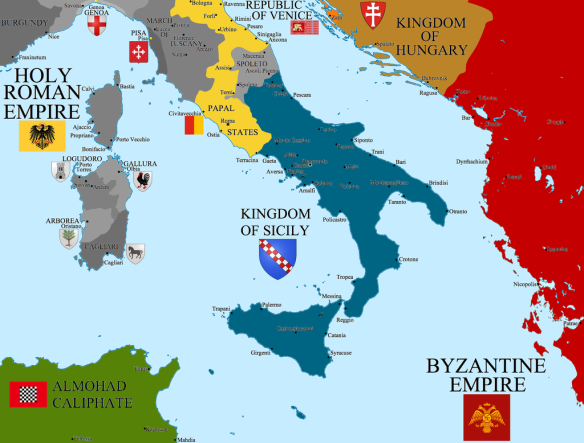The island of Sicily was conquered and settled by Muslim invaders from North Africa in the ninth century and was reconquered by the Normans of southern Italy in the period 1061-1091. Thereafter the island and various mainland territories came to form a kingdom that became one of the major powers in the Mediterranean region.
The Norman conquest was led by Robert Guiscard, duke of Apulia and Calabria, and his younger brother Roger. While Robert’s participation was important in securing the northeastern part of the island (1061-1062) and Palermo (1072), the conquest was largely conducted by Count Roger, and rule over the island was left in his hands.
Certain features of the conquest foreshadowed the First Crusade: there was sporadic papal encouragement, and contemporary chroniclers stress that this was a holy war on behalf of Christendom. Yet while Pope Gregory VII suggested to Count Roger (in 1076) that he “should seek to spread the worship of the Christian name amongst the pagans” [The Register of Pope Gregory VII, 1073-1083, trans. H. E. J. Cowdrey (Oxford: Oxford University Press, 2002), p. 193], in practice many towns surrendered on terms that included the maintenance of Islamic worship and law, and the majority of the island’s population remained Muslim until the late twelfth century. Roger I created six Latin bishoprics and founded a number of both Latin- and Greek-rite monasteries, but Christian immigration was slow (and largely went into the east of the island), and conversion slower. Western Sicily remained largely Muslim until the 1230s, when Frederick II transferred many of the remaining Muslims to northern Apulia.
Detail of the mosaic with Roger II receiving the crown by Christ, Martorana, Palermo. The mosaic carries an inscription Rogerios Rex
The kingdom played little part in the early crusades to the Holy Land. Roger II, count (1105-1130) and then first king of Sicily (1130-1154), was primarily concerned with consolidating his new kingdom, particularly his rule over the southern Italian mainland. Once this had been achieved (by 1140), his forces conducted campaigns against Muslim North Africa (especially in 1146-1148) and Byzantium. Garrisons were established in several coastal cities in Africa, notably Mahdia (mod. al-Mahdiya, Tunisia), Tripoli (mod. Ṭarābulus, Libya), Gabes, and Sfax, but while attempts were made to attract Christian immigrants, the primary purpose of these conquests was to control the lucrative trade between Africa and Sicily. Given its involvement in these operations, the kingdom was unlikely to have resources to spare for involvement in the Levant. In addition, there were cordial diplomatic exchanges between Roger’s court and the Fatimids of Egypt, and indeed the reorganization of the Sicilian administration in the 1140s drew on Fatimid practice.
While there had been a substantial southern Italian involvement in the First Crusade, thereafter interest in the Holy Land appears to have waned. Roger II’s relations with the rulers of Outremer were poor. The marriage of his mother, Adelaide, to Baldwin I of Jerusalem in 1113 and Baldwin’s subsequent repudiation of her left Roger, according to the chronicler William of Tyre, with a mortal hatred against the kingdom of Jerusalem. His unsuccessful claims to succeed his cousin Bohemund II of Antioch after 1130 meant that his relations with that principality were equally hostile. Furthermore, his attacks on the Byzantine Empire in 1147-1148 also contributed to the failure of the Second Crusade in the East.
The Apulian ports, especially Bari, Brindisi, and Otranto, as well as Messina on Sicily, were key embarkation points for pilgrims to the Holy Land, but few southern Italians went there themselves. After a first flush of enthusiasm following the First Crusade, endowments to Holy Land churches in the kingdom of Sicily were relatively few, although the Church of St. Mary of the Latins at Jerusalem did have a wealthy dependency at Agira on the island of Sicily. The military orders established themselves in the kingdom relatively late and (at least at first) on a limited scale. The Order of the Hospital (of St. John) had established separate provinces for Sicily and Apulia by about 1170, but the Templars only established a local organization within the kingdom between 1184 and 1196. The kings offered protection to them and to some of the churches of Outremer, but little material endowment. During the reign of William I (1154-1166) revolts and internal dissension within the kingdom as well as the continued threat of attack from the hostile German Empire contributed to the loss of the Sicilian colonies in North Africa to the Almohads in 1158-1160.
It was only under King William II (1166-1189) that the kingdom started to take a more active part in the crusading movement. An alliance was concluded with King Amalric of Jerusalem to carry out a joint attack on Egypt, although after Amalric’s death (1174) the Jerusalemite expedition was abandoned and the Sicilians, forced to make the attempt alone, were defeated. The Sicilian fleet also attacked the Muslim- held Balearic Islands in 1182, primarily in response to Muslim piracy. However, Sicilian attention was then diverted once more toward Byzantium; a major invasion was launched in 1185 but miscarried, despite the capture of Thessalonica. This attack may well have contributed to the decision of the Byzantine emperor, Isaac II Angelos, to conclude an alliance with Saladin. However, the collapse of the kingdom of Jerusalem in 1187 revived interest in the fate of Outremer, and because of its geographical position and its powerful navy, Sicily was able to provide more immediate help to the embattled states in Outremer than other western kingdoms could. The Sicilian fleet (under Margaritus of Brindisi) played a crucial role in supplying and reinforcing the cities of Tyre (mod. Sour, Lebanon), Tripoli (mod. Ṭarābulus, Lebanon), and Antioch (mod. Antakya, Turkey) in 1187-1188.
